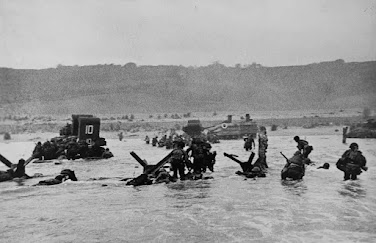LO1: Report: Robert Capa
Name of Photographer: Robert Capa
3 pieces of work by Robert Capa
This photo was taken by Capa during the landing of Omaha beach, it is called D Day due to this being D Day. I personally like this image because it gives you a closer to look at what happened on that day and how they stormed the beaches. This photo also shows what equipment they had, the type of clothing they had to wear and what weapons they had to carry.
This photo is powerful because it shows the effects of war and just how deadly the injuries were. Another reason why I chose this image is because of how close Capa would have got to the victim and the army medic to snap a picture of this due to the camera that Capa had it wouldn't have had much of a zoom.
This is a very famous photo by Robert Capa, in which he caught a picture of a Spanish soldier dying in the middle of no man's land. It was called Death of a Loyalist Soldier. Picture Posted termed him "the greatest war photographer in the world." Although this is an amazing photo as time went on the photograph was suspected to be a fake and staged due to the fact that the soldier is alone and that Robert Capa had to get really close to take the picture. My opinion on this picture is that I am undecided on wether the photo is staged or if its real due to the lack of evidence we have and that Capa is no longer alive. As well as the technology during the 1930s it wouldn't have the best zoom technology and that the film would have a limited amount of shots.
Introduction to Robert Capa:
Robert Capa was born into a working-class Jewish family, his parents Dezso Friedmann (Father) and Julianna Berkovits (Mother) ran a dress salon, in Hungary, his father was a tailor at the dress salon. He had a brother Kornel who was born five years later. Capa had a happy childhood and didn't exceed in school, he still exceeded in making friends. As a teen he fell into a group of student activists, even though he wasn't politically in the group his affiliation with the group caught the attention of the Hungarian police. The Hungarian police then later questioned him about his communist sympathies, while in custody he was beaten by interrogators until being let go due to the police not having anything to convict him on. It is believed that one of Capa's fathers client arranged his release on the condition that Robert left Hungarian.
Despite his interests in journalism, Capa soon turned his head to photography as a way to generate a sort of income. When explaining the decision Capa said "while pursing my studies my parents' means gave out, and I decided to become a photographer, which was the nearest thing too journalism for anyone who found himself without a language." Capa started his career as a darkroom assistant who quickly worked his way, teaching himself to shoot with the agency's Leica cameras. By summer of 1932 Capa left college to pursue as a photographer. His first big assignment was as a war photographer in 1936, when Lucien Vogel of Vu sent him to cover the civil war raging in Spain. He went with another photographer called Taro and the two were in a plane crash but they were remarkably unharmed. In September 1936, Capa took his most famous photograph The Falling Soldier. His coverage in Spain lead to his photo's being featured in Life magazine in November 1936, this sparking the life long partnership between the company and Robert.
Above is the camera that Robert Capa used during his time, it is a 35mm Leica camera since these are very lightweight and are handled which is perfect for the time he spent in Spain, its 35mm film was compact and easy to use which allowed Capa to shoot roll after roll in quick succession. This camera was announced to public in 1924 and was sold to the public just a year later in 1925. This camera was immediately successful and also responsible for popularizing 35mm film.







Comments
Post a Comment